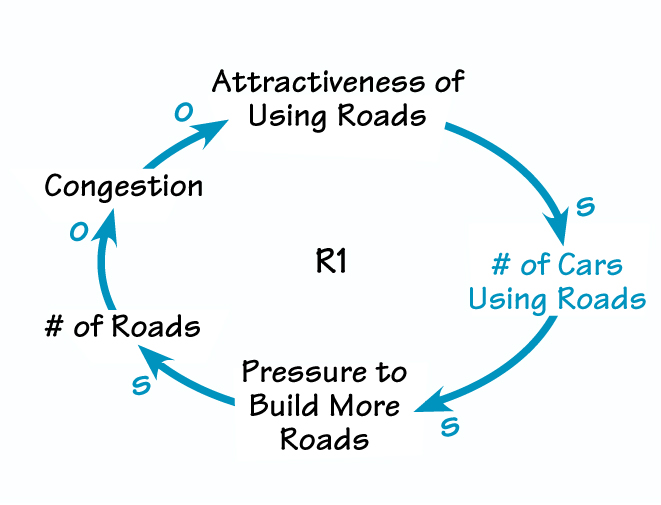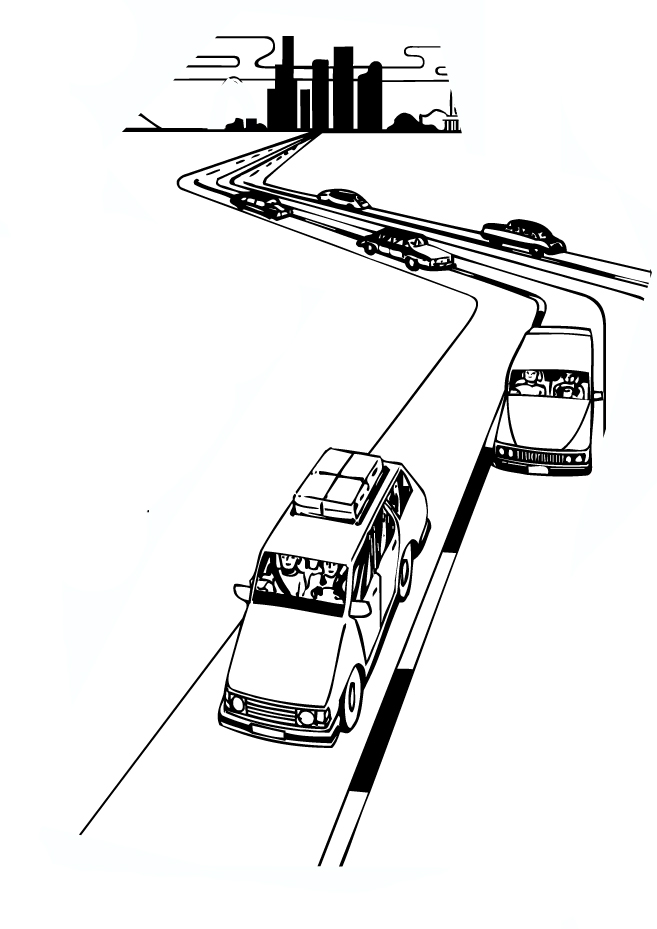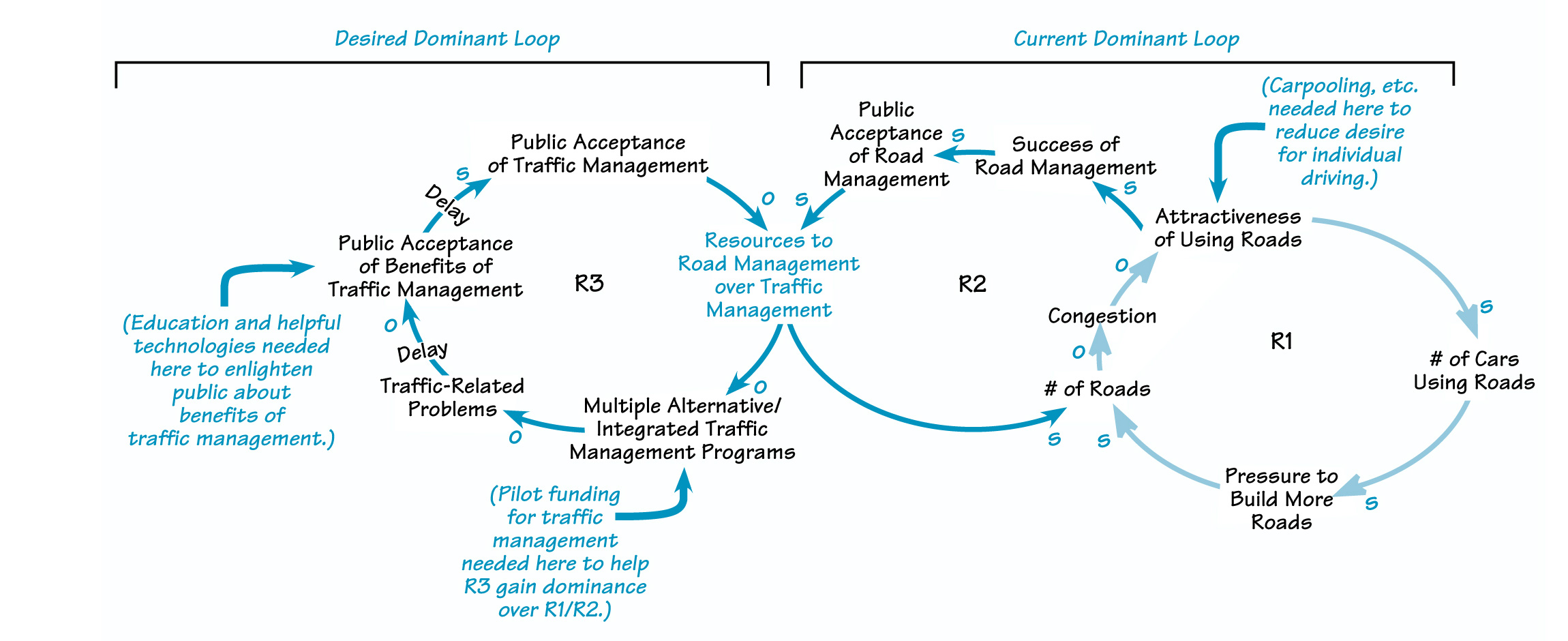For most of us who own cars, the automobile is a powerful symbol of economic status, self-reliance, and individual freedom. A privately owned car lets us choose where and when to travel, and with whom. For that reason alone, the automobile has become the most prevalent mode of transportation in Germany, as well as in many other countries. Today more than 45 million cars are registered in Germany, with the number continually increasing.
Not surprisingly, rising traffic volume has caused extreme congestion on German roadways, particularly in and around urban areas. Traffic delays cost the German national economy approximately 200 billion DM annually. Other problems, such as a reduction in road safety and an increase in pollution and environmental destruction (owing to the continual addition of roads and parking lots), have also been mounting. In the late 1980s, the automobile industry, like many other industries, became increasingly aware of its social responsibilities and sought creative ways to address these problems.
Since the mid-1980s, executives at BMW have recognized that many traffic-related problems can no longer be solved simply by widening or building new roads (see “Too Many Cars, Too Many Roads”). Instead, the entire transportation system — including buses, subways, trams, railways, and airplanes — needs to change. A systemic view, BMW realized, was essential for designing a traffic-management system that could both integrate existing transportation infrastructures and leverage their specific advantages.
A Systems Approach
BMW is in a tricky position: Its mission is to provide consumers with high-quality motor cars that guarantee maximum mobility and pleasure of traveling. Yet the company also realizes that traffic-related problems, if left unaddressed, will ultimately prevent it from fulfilling that mission — even though such problems are not caused by BMW’s products alone. As Mr. Horst Teltschik, member of the Board of Management of BMW AG for Economic and Governmental Affairs, explained in a company brochure, BMW has numerous reasons for wanting to tackle Germany’s traffic problems head-on:
- To fulfill its social and ecological responsibility, BMW is required to have an extensive system competence in the transport sector. . . . It regards this as most easily attainable by drawing up and implementing joint transport projects locally (with partners from politics, public administration, science, and private consultancies) that help the partners to better understand each others’ point of view and to bring them into a systemic correspondence with one another.
- • BMW’s core business activity . . . is directly influenced by the effects of transportation policy. Therefore, it is in the interest of BMW to play an active role in influencing this policy by offering its expertise on questions of transportation and environmental policy to political bodies at all levels, suggesting and preparing solutions, and participating in the proceedings of the relevant organizations.
- Selling automobiles and related services successfully not only in the short term but also in the long term presupposes the efficient functioning of the road system. Commitment to the needs of transportation is, therefore, an essential element in the research and development of new products and services to reduce market risks and support innovation throughout the transportation sector.
Questions for Reflection
- The usual approach to traffic-related problems — especially congestion — is to build more roads. What might be some alternatives to this “road management”?
- Given how passionate people are about their cars, how might BMW and other interested organizations persuade drivers to consider alternative modes of transportation?
- If we think of “road management” as the “successful” side of a “Success to the Successful” dynamic structure, what might make up the other, less successful side of the structure? And how might we reverse the dominance within the structure?
TOO MANY CARDS, TOO MANY ROADS

Munich COMFORT
To brainstorm new ways of meeting the company’s mission and its social and ecological responsibilities, managers at BMW began to ask themselves provocative questions, such as “How can we combine the vision of pleasurable, stress-free traveling with protecting the environment?” and “How can road safety be improved while still allowing maximum mobility for drivers?” Exploring these questions led BMW in 1991 to initiate an integrative transportation research project entitled Munich COMFORT (Cooperative Management for Urban and Regional Transportation). Supported by 50 partners from business, industry, politics, and the scientific community, Munich COMFORT was intended to alleviate traffic problems in the northern section of Munich, where commuter, commercial, and holiday traffic converge.
The main objective of Munich COMFORT was to link the different transportation subsystems of the region into one system. This system would in turn be controlled and managed by innovative information and communication technologies. Accordingly, a major part of the project has involved developing computer programs to optimize the management of traffic streams.
Throughout 1992 and 1993, a central computer system was installed in the building of Munich’s regional administrative authorities. The purpose of the system is to collect data on traffic density, accidents and emergency warnings, weather and travel information, and local and long-distance public and individual transport. The Strategy and Service Center then uses the information to design traffic-control strategies, provide road users with the latest traffic announcements, and recommend transportation strategies travelers might use to reach their destinations economically and efficiently.

The new traffic control systems coordinate the interplay of various modes of transportation through means such as dynamic route guidance, traffic-actuated and variable direction sign systems, diversion of cars to park-and-ride facilities, and a strong emphasis on public transport. Drivers can access the system’s announcements by watching for signs placed above or along the road or by using computer-based route-guidance systems in their cars. Commuters get their information through electronic and up-to-date timetable data. For example, the multilingual electronic timetable information system (EFA) installed at bus, train, and subway stations lets passengers request on-screen route suggestions simply by entering their starting point and destination. The EFA responds with information on the nearest stops, departure and arrival times, transfer information, and fares.
Results and Challenges
The results of Munich COMFORT have been impressive so far. The new traffic-control system has led to shorter trip times, lower operation costs (for example, for the bus and tram systems, owing to shorter trip times), a drop in pollution levels, environmental benefits, less individual traffic, and more traffic safety. From 1991 to 1993, congestion in greater Munich diminished by 30 percent, the number of accidents by 36 percent, and the incidence of accident-related personal injury by 34 percent.
SUCCESS TO TRAFFIC MANAGEMENT

The more successful traffic management becomes (as opposed to road management), the less successful road management will become. Diagram contributed in part by Daniel H. Kim.
The project has had some unintended benefits as well: The cooperation that the project has required among the various transport delivery systems broke down many emotional and political barriers and prejudices. For example, public-transportation organizations realized that BMW truly is interested in solving general transportation problems. Moreover, managers of not-for-profit as well as for-profit organizations learned that their management policies do not necessarily need to be at odds. Indeed, Munich COMFORT has inspired numerous follow-up projects elsewhere in Europe. For example, TABASCO (Telematic Applications in Bavaria, Scotland, and Others), started in 1997, will pursue further developments in the management of public and private commuter transport in inner cities and their outlying regions. Amsterdam, Bergamo, Dublin, Edinburgh, and London are some cities now participating in the project.
Despite these successes, Munich COMFORT has encountered its share of challenges. In particular, the number of partners involved introduced a daunting degree of complexity. As Christoph Huss, representative of the Board for Traffic and Environment, said, the partners have had to cope with one another’s unique working procedures, organizational structures, resources, and decision-making processes; to accept each other’s expertise; and to build mutual trust and confidence.
A Systemic Makeover
As another challenge, supporters of Munich COMFORT have had to think of ways to attract people to the idea of traffic management as opposed to road management. This is difficult: For the system to succeed in the long run, people’s long-held mental models about automobiles and other means of transportation will need to change. As a first step, Huss recommends stressing the benefits of the new system. In his words, “An entire networked transportation system between all transport services would allow commuters an integrated solution in order for them to reach their destinations in as efficient and enjoyable manner as possible. It is also important that transitions between the various means of transportation become more attractive. The better the organization of the interchange points, the more willing the prospective users will be to switch from one mode of transportation to another.”
We can view the thinking behind this project as an attempt to reverse a “Success to the Successful” situation (see “Success to Traffic Management” on p. 10). Two activities — driving personal cars (road management) and using alternate, integrated modes of transportation (traffic management) — compete for limited resources (investment, publicity, etc.). Currently, the right-hand side of the diagram, in which more resources go to road management rather than traffic management, is dominating (R1/R2).
For the system to succeed in the long run, people’s longheld mental models about automobiles and other means of transportation will need to change.
The Munich COMFORT partners have sought to reverse the dominance of R1 and R2 — and set a new reinforcing cycle in motion that eventually reduces the amount of resources going to road management and increases the amount going to traffic management (R3). Given how long it can take for the public to accept the widespread benefits of traffic management (see the delays in R3), the project partners need to think about (1) how to “jump-start” the loop (which they’ve done by launching Munich COMFORT as a pilot program), (2) how long they need to maintain such programs in order to overcome the delays inherent in the system, (3) how to reinforce public acceptance of the benefits of traffic management (perhaps through education and helpful technologies), and (4) how to reduce the momentum of the original loops (i.e., make road management less attractive), perhaps through carpooling and other incentives for lessening individual driving of private cars.
Clearly, BMW, along with its many partners, have made significant strides in “rewiring” this system. With time and careful attention to the dynamics at work, perhaps traffic management will someday prevail permanently over road management.
Carol Ann Zulauf is an assistant professor of adult and organizational learning at Suffolk University in Boston, Massachusetts, and is senior partner at Zulauf & Associates. Frank Schneider is a human resource manager for 900 international employees at Forschungszentrum Karlsruhe, one of the largest research centers in Germany.
OUTLEARING THE WOLVES
Tuesday, November 2, 1999 Atlanta, Georgia
Are you — or others in your organization — new to the richness and diversity of organizational learning, and not sure where to begin? Or are you struggling with how to communicate its power within your own company? Outlearning the Wolves provides a solid foundation in the language, concepts, and tools of systems thinking. Also explore the wisdom and rigor of the other four disciplines — mental models, team learning, personal mastery, and shared vision — as a framework for creating change in organizations.
For more information, please contact the Conference Department at (718) 398-9700
